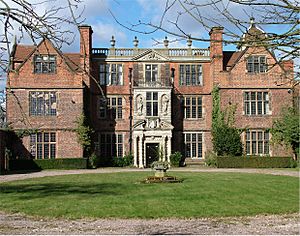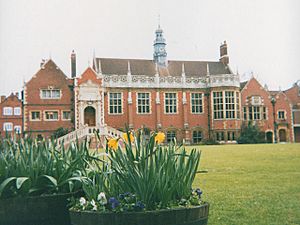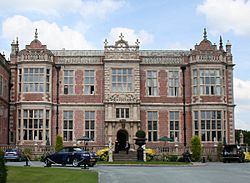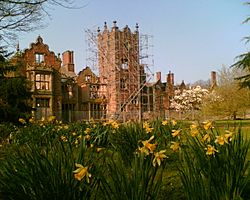Jacobean architecture facts for kids

The Jacobean style is a type of Renaissance architecture that was popular in England. It came after the Elizabethan style. This style is named after King James VI and I, who ruled England from 1603 to 1625. When James became king, building styles didn't change much at first. They continued ideas from the Elizabethan era. But after James died in 1625, architecture started to become more classical. This new style was influenced by Italy and led by a famous architect named Inigo Jones. This later period is sometimes called Stuart architecture or English Baroque.
During this time, important people still built very large and fancy homes called prodigy houses. King James didn't travel around his kingdom as much as Queen Elizabeth did. But the building of these huge houses continued. Ideas from Northern Mannerism in Flanders and Germany became more popular. Often, skilled workers and artists from these places came to England to help build. People didn't build many new churches. Instead, they mostly changed old ones. However, many new non-religious buildings were constructed.
Contents
What Makes Jacobean Style Special?

King James I was interested in new learning. During his rule (1603–1625), England really started to use Renaissance ideas in its buildings. These ideas came to England through German and Flemish carvers. They didn't come directly from Italy.
Even though the general look of Elizabethan buildings stayed, Jacobean designs were more organized. Buildings had a more consistent and planned shape. Architects often used columns and pilasters (flat columns attached to a wall). They also used round-arch arcades and flat roofs. These roofs often had fancy openwork parapets (low walls at the edge of a roof).
These classical elements were used in a free and imaginative way. They weren't always perfectly classical. Builders also mixed in rough-looking stone called rustication. They added decorative details like scrolls, straps, and diamond shapes called lozenges. These details were also common in Elizabethan design. The Jacobean style also influenced how furniture and other decorative arts were made.
Famous Jacobean Buildings
Classical building styles had already appeared in English architecture during the time of Queen Elizabeth I. Architects often used ideas from a book by John Shute published in 1563. In 1577, a book of building styles was released in Antwerp by Hans Vredeman de Vries. This book showed how to use classical elements in buildings. However, the author added many of his own imaginative ideas.
These kinds of books influenced Jacobean architecture. They led to the use of strap work and pierced decorations. These features first appeared at Wollaton Hall in 1580. They became fully developed at Bramshill House, Hampshire (1607–1612), and Holland House, Kensington (1624).
Hatfield House is a great example of a later prodigy house. Robert Cecil, 1st Earl of Salisbury, built it between 1607 and 1611. It has Tudor-style wings with towers and many windows. But an Italianate Renaissance front connects the two wings. This central part was once an open porch. Some people thought Inigo Jones designed it. However, the main entrance looks more like a strong gatehouse. So, it's probably not his design. Inside the house, a beautifully carved staircase shows the Renaissance influence on English decoration.
Other important Jacobean buildings include:
- Crewe Hall in Cheshire
- Knole House near Sevenoaks in Kent
- Charlton House in Charlton, London
- Plas Teg near Pontblyddyn in Wales
- Bank Hall in Bretherton
- Castle Bromwich Hall near Solihull
- Lilford Hall in Northamptonshire
- Chastleton House in Oxfordshire
The Jacobean style was most common in England during the early 1600s. But some examples in Oxford and Cambridge can be found up to 1660. This was even after Inigo Jones introduced a purer Italian style in 1619 at Whitehall.
Jacobean Style in the Americas
In the early 1600s, England started its first successful colonies. These were Jamestown, Virginia in 1607 and Plymouth, Massachusetts in 1620. The settlers who built homes in these new towns often used the Jacobean style. This was the common way to build in the parts of England they came from. For example, the wooden siding called clapboard on houses in New England came from a style popular in Northeast England.
Historians sometimes call this early American architecture "First Period architecture." There was a lot of overlap between the homes of ordinary people in England and colonial America. Some Jacobean features lasted longer in America. This was because the colonists had less contact with the changing styles in England.
When the Puritans arrived in New England in 1620, they had to build homes quickly. It was a very cold winter, and many people on their ship, the Mayflower, were sick. The first buildings in New England looked like the simple cottages in England. These were often made with "wattle and daub" (a mix of woven branches and mud). They had thatched roofs made from local marsh grass.
Most of these early homes had a "hall and parlor" layout. They had a simple chimney in the middle. This was a common feature in British homes since the Elizabethan era. They had a timber frame and a low first floor. The upper floor had exposed beams and space for storage.
Archaeologists studied the remains of houses owned by Myles Standish and John Alden. These houses were in Duxbury, Massachusetts, a town settled by the Pilgrims. The original homes were narrow and small, about 40 feet long and 15 feet wide. This matches the size of homes for common people in England during the Jacobean era.
Examples of original Jacobean architecture in the Americas include:
- Drax Hall Great House in Barbados
- St. Nicholas Abbey in Barbados
- Bacon's Castle in Surry County, Virginia
Jacobean Revival in the 1800s
In the 1800s, a style called Jacobean Gothic or “Jacobethan” became popular for a short time. Good examples of this style are Coxe Hall, Williams Hall, and Medbury Hall. These buildings are part of Hobart College in Geneva, NY. Other notable examples at colleges include buildings at The University of Florida and Florida State University. Both were designed by William Augustus Edwards.
See also
- Jacobean era
- Jacobean Revival




